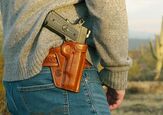Operating Systems 301: What Is Underlug?

Note: In this article, I call this mechanical feature “underlug”. However, this is an error. Several friends of mine and I have been discussing the mechanics of firearms operation for close to a decade now, and we misremembered the term “underslide” from a book by Brassey’s as “underlug”. More details on the error are available in the comments. Regardless, “underslide” is the proper term for this principle, not “underlug”.
When a firearm unlocks, even if the bullet has already left the barrel, some residual pressure remains in the chamber, forcing the cartridge case walls out against the chamber, and causing resistance against the extraction of the spent case from the barrel. Within a single instant, the pressure in the barrel is relieved and the case walls rebound elastically away from the chamber. In a manually operated gun, the reaction of even the quickest shooter is too slow to operate the gun before the pressure in the barrel can drop, so this residual pressure does not present a problem. However, in automatic weapon design the weapon’s mechanism virtually by necessity must begin to operate while pressure in the chamber is still high, and this presents the problem of how to provide energy to the mechanism while there is ample pressure to do so, yet still extract the cartridge case when the pressure drops to a low enough level to allow the case to easily leave the chamber without risk of shearing a rim, or worse.
There are several inventions which solve this problem, including the expanding gas system of the AR-15 and John Pedersen’s cartridge waxing process, but one of the most mechanically sound ways is called underlug. Underlug is a special dimensioning of the cam surfaces on a locked-breech firearm which give the actuating piece space to move before it actually contacts the locking element and unlocks the firearm. As an example, below we can see the underlug on the cam track of an M1 rifle’s operating rod and how it interacts with the unlocking stud on the bolt lug, at the timestamp 5:29 in the U.S. Army video below:
You can see from 5:29 – 5:36 how the operating rod is able to move to the rearward significantly (in reality, roughly 3/8ths of an inch/9mm, although significantly exaggerated in the illustration above) before it encounters the locking stud and forces the bolt open. This delay in unlocking not only gives the operating rod a running start to unlock the rifle, it also allows pressure to drop in the chamber before the extractor is forced to pull the case out, easing extraction.
In the locked position, the bolt is rotated into position and the operating rod is fully forward:
The operating rod is able to move back slightly (~3/8″), but the bolt stays in the locked position and does not yet start to rotate:
Now the bolt has rotated out of alignment with the locking surfaces in the receiver:

Nathaniel is a history enthusiast and firearms hobbyist whose primary interest lies in military small arms technological developments beginning with the smokeless powder era. He can be reached via email at nathaniel.f@staff.thefirearmblog.com.
More by Nathaniel F












![[SHOT Show 2024] PTR is bringing the new Gen II Archon Type B to the US](https://cdn-fastly.thefirearmblog.com/media/2024/05/19/082117/shot-show-2024-ptr-is-bringing-the-new-gen-ii-archon-type-b-to-the-us.jpg?size=350x220)



![[SHOT 2024] Holosun's New IRIS Aiming Device](https://cdn-fastly.thefirearmblog.com/media/2024/05/19/14784043/shot-2024-holosun-s-new-iris-aiming-device.jpg?size=350x220)







Comments
Join the conversation
This term is new to me as well. A quick search only references revolvers.
Do you know it's origins Nathaniel, or have reference material that uses the term?
Guys, it's timing, come on you all know what's going on here. We need time to go by in order to allow chamber pressure to go down to a safe point so we can unlock the breech. How do we do this??? By leaving a space between operating parts or time before contact. Or we would be timing the action to operate correctly. Timing in any operating system is created by putting exact distances between operating parts, or time before actuation. Look at the AK operating system, watch how far the bolt carrier travels before the bolt starts to rotate. I always heard the term timing the action, never heard of an underlug except on revolvers.